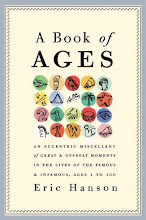On July 4th, 1825, the five year-old Walt Whitman was embraced by the Marquis de Lafayette who was visiting Brooklyn. The poet Whitman appears three times in A Book of Ages, Lafayette once.
A year later, on the half-centennial of the signing of the Declaration of Independence, Thomas Jefferson, the author of the document, and John Adams, a signer, both died, Jefferson at home in Virginia, Adams in Massachusetts. In 1826 Adams was 91, Jefferson 83.
The two men had become bitter political rivals in the early years of the Republic. Jefferson had hired a pamphleteer to smear Adams while the two were running for the presidency in 1800. The pamphleteer was a man named James Callendar, and the smear, while untrue, was believed by enough people to win Jefferson the election. Callendar went to prison over the libel and emerged a year later angry with Jefferson for the unpaid bill. He got his revenge by publishing a true story about the sitting president: that he'd had an affair with one of his slaves, a woman by the name of Sally Hemings, and had fathered children by her. The story dogged Jefferson for the rest of his life.
After the inauguration in 1801 Jefferson and Adams would not speak or write to each other for another decade. The reconciliation, when it came, was a warm one. The letters between Jefferson and Adams comprise one of the most interesting correspondences ever written, describing the intelligent differences of opinion––religious, philosophical, practical, political––which formed our country. Jefferson appears four times in A Book of Ages, John Adams five times.
Saturday, July 4, 2009
Subscribe to:
Post Comments (Atom)





No comments:
Post a Comment